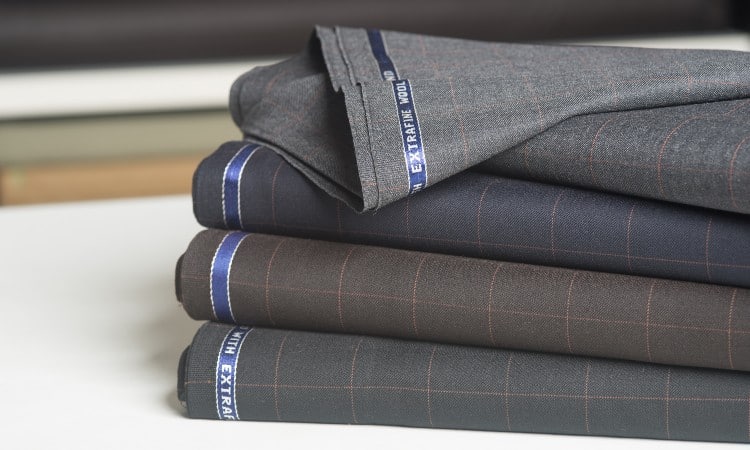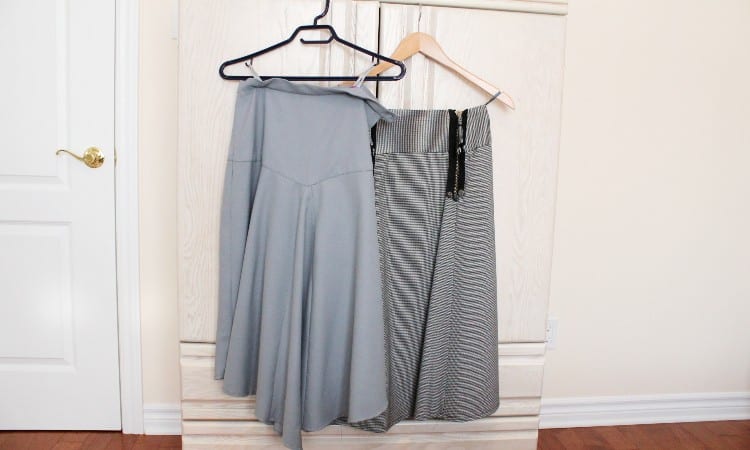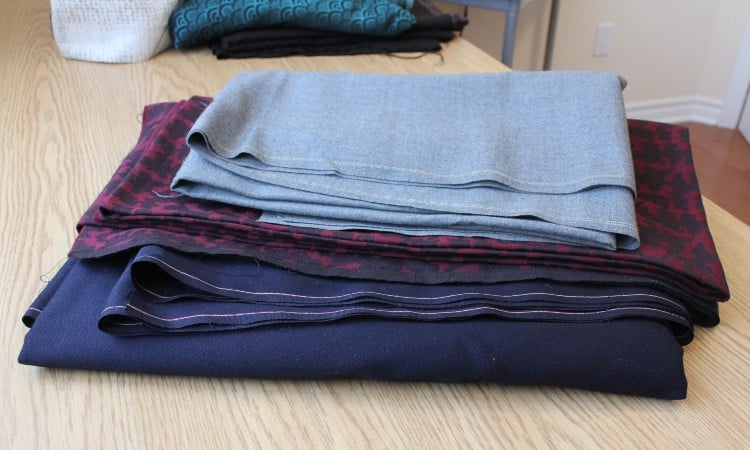The different weights listed on fabric rolls can be confusing. Terms like “bottom weight fabric,” “top weight fabric,” or even “lightweight” and “heavy weight fabric” are recommended in patterns, but what do they stand for? What do the terms and all the numbers mean? What is bottom weight fabric?
Different fabric weights are the outcomes of the differences in how fabrics have been woven, what finish has been given to the fabric, and what type of fiber the fabric has been made of. Bottom weight fabric often refers to medium to heavy weight fabric.
In this article, we’ll learn what fabric weights mean, what bottom weight fabric is, and what bottom weight fabric is used for. We’ll also take a look at tips on how to best work with bottom weight fabric!

Understanding Fabric Weights
What Fabric Weights Are
Fabric weight can be measured in two ways. The U.S.l measurement of ounces per square yard, OZ (oz/yd2, oz/sqyd, or OSY). The metric measurement of fabric uses grams per square meter (g/m2), which is usually referred to as GSM, is also commonly used.
Thus, the higher the fabric values on the GSM or OZ charts, the heavier the cloth.
- Extra Light is 2-4 oz/yd2 (8-132 GSM)
- Lightweight falls between 4-6 oz (136-204 GSM)
- Medium weight fabrics 6-8 oz/yd2 (204-272 GSM)
- Medium Heavy are 8-10 oz/yd2, (272-339 GSM)
- Heavy weight cloth in the 10-12 oz/yd2 (339-407 GSM) range
- Extra Heavy is 14+ oz/yd2 (407+ GSM).
Fabric weight is not to be confused with fabric strength. It’s easy to mix them up. What’s the difference? The weight of the fabric simply shows how heavy the fabric is and is not an indicator of tensile strength. If you would like to test the strength of your fabric, visit this link to learn more.
Why There Are Different Types of Fabric
Different fabric weights affect the application of the fabric. Generally speaking, the heavier the fabric is, the thicker it would be, and vice versa. Heavier cloth is more able to withstand hardwearing than lightweight ones, as the fiber and thickness of the fabric can last longer under adverse situations.
Lightweight fabrics are more fitting for clothes to be worn in hotter temperatures. Heavy cloth would be more suitable for jackets, pants, and curtains because they block out cold or light, provide more insulation, and offer more structure than lighter weight fabric.
Another categorization of fabrics to consider when choosing cloth to work with is woven cloth versus knitted. Generally, knitted fabric weighs more than woven; however, both types of cloth have their own advantages.
Types of Fabric Weights
Fabrics generally fall into six categories. These are extra light, lightweight, medium weight, medium heavy, heavy weight, and extra heavy weight fabrics. Here are some examples of different weight fabrics:
Extra Light weight (2+oz) includes viscose and jersey.
Lightweight fabrics (4+oz) are cotton, chambray, and PVC.
Medium fabric (6+oz) includes Oxford, taffeta, and charmeuse cloth.
Medium Heavy (8+oz) materials are linens, canvas, Polyester, linen-wool blends,and thinner velvets.
Heavy weight (10+oz) fabrics include wool, canvas, denim, brocade, and upholstery fabric.
Extra Heavy weight (14+oz) fabrics are tweeds, canvas, denim, velvet.
What Different Weights Are Used For
- Extra light weight fabrics are used for undergarments, jacket liners, and performance gear.
- Lightweight fabric is usually used for blouses, t-shirts, craftmaking, and men’s underwear.
- Medium weight fabric can be used for summer jackets, pants, shirts, skirts, dresses, outdoor clothing, and bags.
- Medium heavy weight material is used for thicker shirts, trousers,and dresses.
- Heavy weight cloth is usually used in making tents, flannel nighties and shirts, denim coats, uniforms, curtains, umbrellas, and other outdoor apparel items.
- Extra heavy weight fabrics are used for heavy winter clothing, upholstery, sports jackets, hoodies, and curtains.
Sometimes fabric is listed as either top weight or bottom weight. What does that mean?
What Is Bottom Weight Fabric
A Quick Definition
Bottom weight fabrics, made of various types of fiber, are used to make jeans, suits, skirts, and pants. Bottom weight fabric generally measures in the medium to heavy weight range, or between 8-16 oz per square yard. This type of fabric is usually woven. Twill, sailcloth, and denim are examples of bottom weight fabric.
How Bottom Weight Fabric Is Different From Other Kinds
Besides being different from lightweight fabrics and knitted cloth, bottom weight fabrics are the antithesis to top-weight cloth or shirtings. Top-weight cloth can be eighth woven or knitted and is used to make shirts and light dresses, and other items that require light-weight fabric. Top-weight fabrics include broadcloth, chiffon, and crepe.
Here’s one way to remember this. Top weight fabric is what you usually use to make tops, and bottom weight fabrics are what you would use to make bottoms.
Types of Bottom Weight Fabric
Twill is one of the three original weaves in the textile industry and is identifiable by its diagonal rib patterns, as opposed to the straight weave patterns in satin and plain weave. Twill was originally made with cotton, but now both natural and synthetic substances, like polyester, are used. Most types of bottom weight fabrics are based on twill. Twill is used in making bed sheets, curtains, towels, and other homewares.
Chino is made from cotton fibers and comes from a cloth originally fabricated in China. They are sturdy, long-lasting, and breathable. Chinos are a little lighter than denim and are somewhat more formal in appearance. Chinos is used by the American and British military and has a sheen to it.
Denim is one of the best known and widely used bottom weight fabrics in the textile industry. Denim is made from cotton fibers and is a sturdy, twill-weave woven cloth. Usually, denim is white on the inside and blue on the outside. Denim is widely used in making jeans and jackets.
Tweed is usually made of coarse wool yarn, and commonly used in making trench coats, winter clothing, and other outerwear items. Tweed originated in Scotland and has now become more of a niche fabric. It is very insulating and durable.
Uses for Bottom Weight Fabric

What Can You Do With Bottom Weight Fabric?
Bottom weight fabric has been used to make lots of different clothing items and household items. Due to the durability of bottom weight fabrics, they are used in a lot of different items. Here are just a few examples of what bottom weight fabric can be used for!
- Jeans
- Pants
- Skirts
- Coats
- Jackets
- Uniforms
- Towels
- Dishcloths
- Carpets
- Curtains
- Bed linens
- Blankets
Working with Bottom Weight Fabric
Things to Look Out for When Using Bottom Weight Fabric
Just like using any other heavy fabric, there are a couple of things that you needt to keep in mind to avoid any trouble or problems in sewing. Here are some tips for working with bottom weight fabric
- Make sure to use thicker, more durable needles when sewing with bottom weight fabrics.
- Seams in heavier, bottom weight fabrics can be difficult to manage well. Try pressing the seams with a light touch of the iron with some steam, then pressing the seams with your fingers.
- It might be easier to use traditional zippers with heavy fabrics, as opposed to the invisible zippers. This would make the seams and sewing process a little easier. Feel free to experiment, though!
- When making clothes with bottom weight fabric, it might help to make pockets, waistbands, and other facings with lighter cloth, as this would help the garments lay better on the body.
Using Other Cloths With Bottom Weight Fabric
Since bottom weight fabric is heavier and denser than light-weight or top-weight fabric, keep in mind that the different drape and weave of the various fabric weights can impact the usability, appearance, and overall performance of your finished product.
Bottom weight fabric can be combined with lightweight fabrics to create a cloth that is more durable, insulating, and light-blocking, as in making jackets and curtains.
It may be difficult to use lightweight cloth and bottom weight fabric on the same layer, as the weight of the bottom weight fabric, and the stitches necessary to work with the bottom weight, can have an adverse effect on the lightweight cloth and thus, on the whole, finished product.
Where to Get the Best Bottom Weight Fabric
Recommendations
Here are two online fabric shops that sell a wide variety of bottom weight fabrics. Pick and choose your favorite prints and start making wonderful pants, shorts, and other things!
- Harts Designer Fabric offers stylish and sturdy bottom weight fabrics that you could use to make jeans, skirts, trousers, and shorts.
- Blackbird Fabrics also offers lots of bottom weight fabric to choose from, at affordable prices.
- MasterFAB Cotton Fabric – Amazon.com
What to Look for When Choosing Fabric
Make sure that the fiber type, finish, and cloth type you purchase fit what is needed for your project(s). Remember that heavier cloth, such as bottom weight fabric, is used for clothes that need to withstand wear and tear.
Lightweight fabrics are more for softer, flimsier clothes and crafting. Also, keep in mind that woven and knitted clothes have their own pros and cons, and would make a difference in what your finished product would be like.
What to Keep in Mind When Purchasing Bottom Weight Fabric
Remember to keep your projects and intended use for the fabric you are looking for when shopping for bottom weight fabric. Match the type of weave, fiber, and finish to the requirements you have for your project. You won’t want to make the mistake of having overly heavy blouses, funny-feeling underwear, or mismatching weave patterns for a single project!
Conclusion
Bottom weight fabric refers to medium to heavy weight fabric that is durable and made with a twill weave. Denim, chino, and tweed are all examples of bottom weight fabric. This type of cloth is used to make pants, jeans, skirts, and various types of outdoor apparel, as well as houseware such as dishcloths, towels, and bed linens.
We hope this article has answered some of your questions about bottom weight fabric. If you have any comments or questions about anything mentioned in this post, please let us know, and we would be glad to help you! Bottom weight fabric is something all of us use on a daily basis; and for sewers, an understanding of what bottom weight fabric is, how it is used, and how to work with it, is essential.
